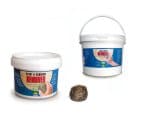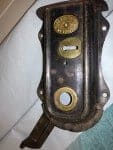Guest blog by Wayne de Wet – Multiple Award Winning Decorator
‘My client’s home was built in 1880 in the City of Norwich, Norfolk. The foundations of the previous house, which must have been much bigger, can still be found under the front garden. Remains of the past often find their way to the surface of the back garden – old salt pottery; a stable-chain, even pieces of willow china.
My client’s parents bought the house in 1931, and paid £1200 for a four-bedroom house! She lived in the house with her parents until she was 18, but life took her away to university, then teaching, and finally marriage. Returning with her family in 1976, she has lived there ever since.
The original door of the greenhouse had coloured and engraved glass panels. It survived the Blitz with only a few minor cracked panes of glass but sadly was replaced in 1947 due to extensive rot in the frame.
The story of the door was one of many I really enjoyed listening to whilst on my lunch breaks working for this client, which always consisted of “a proper pot of tea, with real cups and saucers, and a real milk jug” – not to mention the tea cosy and biscuits and cakes served on a wonderful plate. Proper old school!
So after getting such treatment I wanted to do something for her – restore the Victorian Surface Lock from the original green front door. It was going to be quite a task, with many coats of paint to remove; with the house being built 130 years ago that’s a lot of paint!



My studio was the ideal place for the work, as it’s out the way and everything I need is to hand.
My list of things needed for the restoration:
Home Strip
Stainless steel scourer
Purdy stainless steel wire brush
Suitable gloves, overalls and goggles
OneTuff cloths and clear plastic bag
Screwdriver and metal spoon
Camera phone
Old waste paper (Envelopes or Newspapers)
A bucket of soapy water and a bucket of warm clean water
Hammerite smooth black aerosol
As a multiple award-winning professional decorators with 35 years in the trade, I have used virtually every paint stripper on the market.
But for this “Special Project” I wanted to find out what was recommended in interiors
magazines or on a website, something that a DIYer or pro-decorator would feel safe and confident in using.
By sheer chance, I noticed a tweet from Jo from “A Passion for Homes”. She had put a shout out for questions for a Celebrity Interview she was doing with the iconic Eco interior designer Oliver Heath.
Now if I am honest, I don’t have much luck with these random tweet thingies, but I thought of all the cups of tea and biscuits I had enjoyed at my client’s house, and just went for it – and was well shocked when I was chosen from the many questions that must have been tweeted!
This was my tweet…
“Practical question from @ToolTalk1 on Twitter – what would you recommend to strip paint off an old metal Victorian surface door lock that’s got years of paint built up on it?”
This was Oliver Heath’s answer via Jo’s interview for A Passion for Homes…
“There’s a product called home strip – but you must be careful if you google this product!! – and this is basically a paint stripper that isn’t full of horrible acids, so when you use it, it doesn’t burn your hands and is much nicer to use at home, so I would recommend they use this product”.
Although I had heard fantastic reviews of the Eco solutions @Homestrip & @Tradestrip, and I had used other products in their range, I hadn’t had a chance to try the Home Strip paint stripper, so to have a recommendation from Oliver Heath was all the prompting I needed.
With my phone, I took a few pictures of the inside of the lock so it would be easy to reassemble and then prepared a suitable area in my studio, by placing a Trimaco OneTuff cloth on a small waste piece plywood. I then placed the lock and kept it flat on an old envelope.
I wore my gloves and goggles and all times, it’s best to be safe than sorry! I didn’t want the stripper flicking into my face or getting under my fingernails, which could easily happen.
Then I simply spooned the Home Strip onto the Victorian surface lock.



I used a clear plastic bag both under and over the item being stripped, to keep it moist for longer, and had a little peek every couple of hours, while the product did its magic.
After leaving the Home Strip overnight, I decided to take a look, and was amazed at what I found…
I dried the lock, and anywhere where the paint had not completely been removed like in the little crevices, I simply reapplied the Home Strip paint stripper, covered with the clear plastic and leaving overnight again.
It was amazing – 130 years of paint seemed to be dissolving with no effort at all, so I got my stainless
scourer and Purdy stainless steel wire brush, and with soapy water scrubbed the paint off with ease!
Note the stamped brass registration tab, and also the thick solid brass keyhole, and even the spindle hole.
In the studio I have one of the wife’s old hairdryers, a quick blast with that made sure it was totally dry.
Then came the fun bit, I very carefully cut and stuck Trimaco clean edge masking tape to the brass parts of the lock. This was so important as after spending so much effort removing 130 years of paint, I didn’t want it anywhere it shouldn’t be.
Lastly, I got the can of Hammerite smooth black aerosol and shook it. For best results always test spray onto something else to see the spray fan size and pattern before you begin. When you’re happy keep the can moving as soon as you press and spray.




Thin even coats are the best way to apply it and always wait the required 15 minutes between coats. Thin multiple coats will also ways look better than fewer thick coats! If you overload and spray too thickly, you will get runs and the paint may crinkle.’
Wayne de Wet
Multiple Award Winning Decorator
Grand Winner Dulux Select Decorator of the year 2011
@ToolTalk1
@Decorum28
Full interview with Oliver Heath on http://www.apassionforhomes.com/celebrity-interviews (Update 13th August 2019 – The “A Passion For Homes” Website is no longer functioning)
Source: Passion For Homes





